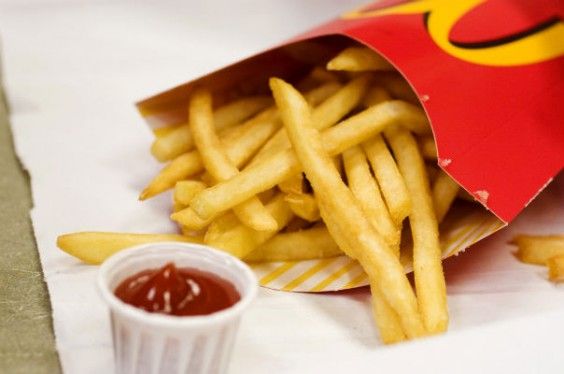Photo: Robyn Lee
Salt-and-sugar goliath McDonald’s is concerned about your health. That’s why, as part of their 2014 “commitment to offer improved nutrition choices,” they’re planning on letting customers swap fries for a side salad in any of their value meals.
Since posting their first sales decline in over a decade late last year, McDonald’s performance has been pretty choppy across the board — even their dollar menu failed to boost sales. So it’s no surprise they’re trying to change their direction, but how exactly does the fast food icon envision “improved nutrition”?
According to press material, they have a lot to be proud of — and perhaps a lot to stay quiet on. McDonald’s says, for instance, that in the past year their restaurants have served more than 200 million cups of fruit through menu options like Fruit & Maple Oatmeal, while neglecting to mention this dish contains 32 grams of sugar — more than a cup of Coca-Cola. McDonald’s is also excited to tell you that since August 2012, they’ve served more than 220 million cups of low-fat dairy, like their fat-free, kid-targeted chocolate milk that clocks in at 22 grams of sugar — more than half the recommended daily intake for an adult male.
What’s most curious is the pledge McDonald’s made to the Children’s Food and Beverage Advertising Initiative to ensure eight of their Happy Meal options offer “at least 1 ½ servings of at least one recommended food group and three or more essential nutrients.” Take a look at one of the questionable meals that fall under this umbrella:
Sample “Healthy” Meal
- 4 Chicken McNuggets(190 calories, 12g fat)
- Kid’s size fries (100 calories, 5g fat)
- Apple Slices (not “apple slices,” but “Apple Slices” – chopped apple dipped in calcium ascorbate) (20 calories, 3g sugar)
- Fat-free chocolate milk (130 calories, 22g sugar)
That clocks in at 25 grams of sugar, 17 grams of fat, and 440 calories.
While a standard happy meal of cheeseburger, fries, Apple Slices, and a Coke is certainly a worse choice at 32g sugar, 17 grams of fat, and 515 calories, the first meal is far from a healthy option — particularly for food aimed at young children.
When McDonalds does add salads to their meals — even some salads with more calories than a quarter pounder — very few people buy them. Salads make up just 2 to 3 percent of McDonald’s sales, which begs the question: Is the company’s new direction intended to get their regular customers to make better choices, or do they expect new customers to come in for healthier meals? Historically, neither outcome seems likely, at least in the near future.
The announcement of McDonald’s salad substitution strategy (say that three times fast) comes in the wake of Burger King’s lower-calorie Satisfries, which were released earlier this week (perhaps in response to their own flagging sales). Both companies seem determined to boost their growth by attracting the health-conscious without alienating their core customer base.
While we’re skeptical as to whether these changes will change the way the health-conscious view fast food, it’s too early to be sure. It’s doubtful this direction will have a big impact on McDonald’s claim to be a “healthier” fast food option. But that’s not really the point. McDonald’s is adding these salads to help restore its image and appeal to a more current, more health-conscious demographic. But it’s a lot better than nothing.
Photo: Rosie Tulips


